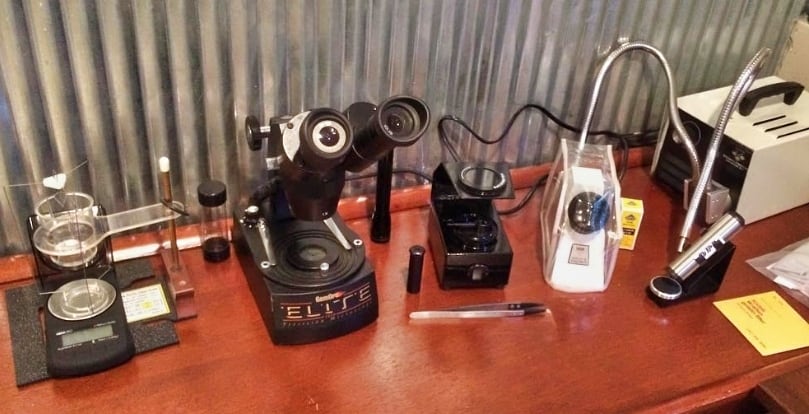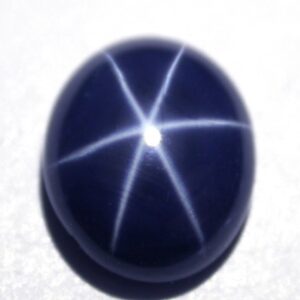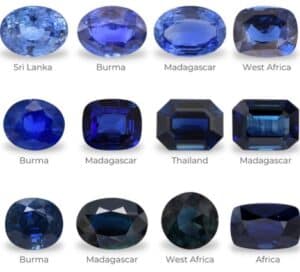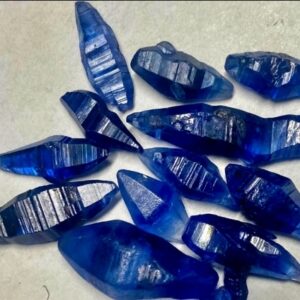Sapphires are highly sought after and command high prices per carat when they have excellent clarity and color. When identifying sapphires you need to be aware sapphires come in different colors even though sapphire is the blue variety of corundum. Most of the time dealers will call sapphires that are not blue, fancy colored sapphires.
The most valuable sapphire is a cornflower blue or Kashmir but there’s a rare color called padparadscha which is one of my favorite precious gemstones. Most gemstone collectors have never heard of or even seen a real padparadscha sapphire. So, if you get the chance to see and hold one then make sure you take advantage of the opportunity.

How to Identify Sapphire Through Testing
There are various ways to identify rocks, minerals, crystals, and gemstones, but we will be using a method I learned while attending the Gemological Institute of America. If you’ve learned a unique way to identify gems, then feel free to share it with us.
Let’s take a deeper look into how to identify sapphire as a pro.
Visual Inspection
The visual inspection starts with what form of Sapphire you have. The questions below are relatively easy to answer, but each type will have its own process for identifying them.

Is it a cabochon? If you’re dealing with a cabochon, then it should have a high polish with very little pitting on the surface. If you’re dealing with a cab and you’ve determined it’s a sapphire then it will probably display asterism, star like effect. Sapphires will have 6 ray star but don’t confuse them with fake or man-made ones.

Is it faceted? If you have a faceted piece of sapphire, it should be transparent or translucent depending on quality. You’re going to need a 10x-powered loop to view the inside of the stone so you can look for signs of inclusions. Most sapphires have inclusions and the most common is silk. These are naturally occurring and can be removed or lightened by heating the stone. Keep in mind most sapphires are heated and that is an acceptable treatment.

Is it a specimen? Sapphire is found in different forms. You’ll get better at identifying these forms by looking at and inspecting this mineral over time. Here’s a list of characteristics Sapphire displays when it’s a specimen.
- Mostly translucent with a natural gray-blue or gray-purple interior with a dark brown exterior.
- You’ll be able to do the streak test on a testing plate. Keep reading below if you have a rough piece with no commercial value.
- An iridescence effect on the outside surface. If you take the specimen into a dark room and shine a light through it, the same color as the Sapphire should reflect back.
- It can be found in crystal form, but it’s rarer, and you’re not likely to come across it very often. These crystals are typically on the smaller side.
Is it tumbled? Not very common to find tumbled sapphires. Again, metallic shine with very little pitting. Beautiful blue colors, with clear, gray, and brownish-gold inclusions throughout.
Physical Properties of Sapphire
Let’s take a look at the physical properties of sapphire. Knowing what to look for will help you more easily identify what you’re looking at.
Color: Colorless, White, Blue, Green, Orange, Yellow, Pink, Brown, Purple, Black, Gray, Multicolored
Clarity / Transparency: Transparent to Opaque
Luster: Virtuous to Adamantine
Cleavage: None, but may exhibit parting
Fracture: Conchoidal, Splintery
The Streak Test
This is a destructive test, so you need to ensure that you’re allowed to damage the specimen or stone if you choose to use this method. Once you’ve developed robust knowledge in identifying rocks and minerals, you won’t be using destructive tests.
A mineral streak test involves scraping the stone against a harder surface to see what color remains. When dealing with Sapphire, you’ll notice the streak is colorless.
Tumbled specimens are tested by scraping a specimen across a piece of ungalvanized porcelain, typically known as a streak plate.
Magnet Test
Most colored Sapphires show some degree of magnetic attraction. However, in some cases, the iron content is too low to be magnetically detectable. Several yellow Sapphires have been shown to be diamagnetic, meaning they offer a very weak form of magnetism induced by a change in their orbital motion.
On average, green sapphires show the highest magnetic attraction compared to other colors of transparent types.
Hardness Test
I don’t recommend actively testing the hardness of a stone because it’s destructive in nature and doesn’t really provide a definite answer to what type of stone it is. With that being said, Sapphire has a hardness of 9 on the Mohs hardness scale.
Refractive Index Test
Determining the refractive index, or RI as it’s referred to by gemologists, for Sapphire is relatively straightforward, but you’ll need a specific piece of test equipment and the RI fluid to go with it. Before you place the stone on the refractometer, you want to make sure you have a flat, somewhat polished surface to take a reading.
Sapphire’s Refractive Index: 1.76 – 1.77
Each gemstone has its own RI, so discovering a sample’s RI can help you figure out what sort of stone it actually is.
Step 1 – Place a small bead of RI fluid on the metal surface of the refractometer near the back of the crystal hemicylinder (the window on which the stone will sit).
Step 2 – Place the stone facet face down on the fluid dot and slide it toward the middle of the hemicylinder crystal using your fingers.
Step 3 – Look through the viewer lens without magnification. Continue looking until you see the outline of a bubble, then look at the bottom of this bubble. Take the reading from there, rounding the decimal to the nearest hundredth.
From time to time, you’ll run into the issue of not having a flat surface to work with. In this instance, you’ll need to leave the top of the refractometer open and hold the rounded stone with your hand. Hopefully, you’ll be able to pull a reading off the gauge.
Birefringence Test
Sapphires are birefringent and offset a wave transmission of 0.8 at right angles to the optic axis.
Consider testing the birefringence, as well. Birefringence is related to RI. While doing the birefringence test, you will turn the gemstone on the refractometer six times throughout the observation period and note the changes.
Perform a standard RI test. Instead of keeping the stone still, gradually turn it 180 degrees, making each separate turn about 30 degrees. At each 30-degree mark, take a new RI reading
Subtract the lowest reading from the highest to find the stone’s birefringence. Round it to the nearest thousandth.
Birefringence: 0.8
Single or Double Refraction
Sapphire has a double refraction.
For this test to be accurate and beneficial, the stone needs to be transparent in nature. If the light won’t pass through the stone, then there is no way to test for single or double refraction.
Check for single or double refraction. Use this test on translucent and transparent stones. You can determine whether the stone is only singly refractive (SR) or doubly refractive (DR) to help identify it. Some stones can also be classified as aggregate (AGG).
Turn on the light of a polariscope and place the stone face down on the lower glass lens (polarizer). Look through the top lens (analyzer), turning the top lens until the area around the stone looks darkest. This is your starting point.
Turn the analyzer 360 degrees and watch how the light around the stone changes.
If the stone appears dark and stays dark, it is likely an SR. If the stone starts light and remains light, it is likely AGG. If the stone’s lightness or darkness changes, DR is likely.
Checking The Diaphaneity
Diaphaneity refers to the mineral’s ability to transmit light. For instance, some minerals are transparent or translucent. When they’re thick, a small amount of distortion might occur, but light will pass through them relatively freely.
Sapphire is translucent. However, its transparency depends on the form it has taken. If the Sapphire has an earthy form, there won’t be much light traveling through it. Instead, the same color of the stone should bounce back. Still, if it happens to take on a crystalline structure, you should expect an opaque diaphaneity.
Finding The Specific Gravity
Every stone has its unique specific gravity, which helps us identify them. Specific gravity is one of the best properties to measure when identifying mineral specimens. Most minerals have a narrow range of specific gravity, so getting an accurate measurement can go a long way toward identification.
Specific gravity is a unitless number describing how heavy a mineral is compared to equal volumes of water. For example, if a mineral is three times as dense as water, it’ll have a specific gravity of three. This is useful because while two minerals might be the same size, they’ll each have a different specific gravity.
The larger the sample, the more precise the readings tend to be. Remember that this technique can only be used for single mineral or crystal masses. It will not work for minerals embedded in host rocks.
Sapphire’s Specific Gravity: 3.9 – 4.1
As helpful as specific gravity is for identifying minerals, amateurs are usually constrained by the lack of necessary tools. However, one way to work around this is to hold the specimen and note how heavy or heft it feels compared to what you might expect a specimen of that size to weigh.
If you want to determine the specific gravity of your stone like a pro, then you’ll need to invest in a higher-end scale. This is the one gemologists use OHAUS Density Determination Kit.
Identifying Rocks and Minerals Like a Pro
Hopefully, you feel confident in identifying a piece of sapphire after reading and applying this guide. You’ll be using the visual part of this guide the most, and you’ll get better as you interact with more gemstones. Before you know it, you’ll be identifying stones like a gemologist.
If you run into any issues or get confused, feel free to reach out, and I’ll do my best to assist you in the identification process.
- Identify Enstatite - March 12, 2024
- Identify Cerussite - March 3, 2024
- Identify Bytownite - February 18, 2024

3 Responses
Being a Mineralogist, this article is very very useful and helpful for a budding Gemologist. Thank you very much for this
Thank you for the help!
No problem!! Happy to help out.